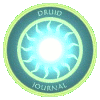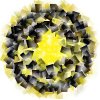Guest Author: Eric Slade Roberson of Shift Your Spirits
A few months ago, Slade was kind enough to invite me onto his site as a guest author, where I took the opportunity to summarize the How to Choose a Religion series. (That summary has things in it that I still haven’t gotten around to here on my own blog!) I jumped at the chance to have Slade write something for the Druid Journal in return.
Slade is an author of tremendous energy and creativity, and an experienced medium and Reader as well. In Drawing Cards he describes a new way of using the Tarot, one that draws directly from the images in the cards — in my opinion, the greatest strength of the Tarot.
Storyboarding the Tarot is an advanced way of working with Tarot decks, doing card readings for yourself, and interpreting the readings in an intuitive manner that does NOT require advanced knowledge of traditional meanings of the cards. Storyboarding is a way of presenting a visual narrative in crude, sketch format – mapping a sequence of still images – frames. Comic books and graphic novels are essentially an intentional, finished, polished form of storyboarding. Storyboarding is used by film makers as an outline or guide for making finished products like movies or television commercials. Storyboards are a standardized development format – you can find sketch diaries and notebooks with pre-printed storyboard pages in better office and art supply stores. Plain, unlined paper is fine.
Sketching Your Readings
The Tarot is a narrative tool – a pictographic story-telling device that lends itself well to this modern work-flow. Storyboarding the Tarot is a universal journaling exercise; the process works with:
- any deck
- any experience level
It’s particularly effective for doing solo-readings.
Advanced Concept for Any Level of Experience
I like this reading process because it can work for a wide range of Tarot Experience Levels – from the Beginner, just starting to learn the individual card meanings, to the Old Pro, who may be bored, stuck in a reading rut, or just looking for a fresh approach that allows readings to feel new again.
The creative process of doing Tarot card readings is enhanced, while the “rules” are relaxed.
Throw Out The Book
Storyboarding or Sketch-journaling your Tarot Readings down-plays dependence on the book of card meanings and “canned” interpretations that come along with your deck. I’ve been playing with Tarot cards for almost three decades now, and I’ve run across a spectrum of serious Tarot Masters – some are strict traditionalists who stick with well-known spreads; others have their own quirky methods that celebrate the unconventional.
All Tarot Masters seem to agree that relying on an accompanying book’s interpretations at the expense of connecting to your intuition is a major hurdle to overcome. My personal introduction to reading Tarot cards was a hard-core sink-or-swim event: when I was nine years old, I told my aunt, who read cards, that I wanted to do it. So she handed me her Tarot deck, guided me through the shuffling and a Celtic Cross layout and then said “Okay, read them.”
I’m sure I looked across the spread at her like a deer caught in headlights, with panicked thoughts that all began with “But–“
She was persistent in her tough coach approach: “This is not a test, there’s no right or wrong. It’s a story. Just tell me the story.”
Even Your Inner Child Can Do This
Free your mind from data, intellect, and judgment. When executing your drawings, think Pictionary, Stick-Figures, children’s drawings. The quality of your artistic ability is not on trial here. If you are a gifted artist, and the results are gorgeous – cool, you’ve got a new series for your next body of work; if your drawings look like a 4 year old did them, that’s okay too.
Drawing from the deck is meant to be a process, not a product.
Source for this concept: In the 2006 Llewellyn Tarot Reader anthology, author Mary K. Greer writes about a man who kept a Tarot journal in which he recorded line drawings of the cards (in a Celtic Cross spread), eliminating the card borders so that the intuitive interaction of the images can be more easily discerned.
Drawing your cards:
Start out with 3-card “spreads.” It might be better to think of the 3 cards as simply groups, as opposed to spreads. Move the 3 cards around in composition, or relation to one another, as you wish. You’re looking for Whole Images to emerge. If the composition makes more sense as a single image by a particular arrangement of the cards – go with that.
Once you have a composition that makes sense, record a crude “map” of that composition as a single sketch in your journal. Remember: think Hangman, Pictionary, Stick figures, kindergarten refrigerator art. Use crayons or colored markers as you wish – color is an important intuitive short-hand.
Impose a 20 minute time limit to keep you focused on the end result and free from inhibitions about the “quality” or sophistication of your drawings.
Interpreting your drawings:
Tarot has always been a narrative divination tool. Journal, write, record the story you see. Again, think of how a child might explain “what’s going on in this picture.” This isn’t a police report – let your imagination run away with you.
Don’t embellish the picture by drawing detail – embroider the story you tell about the picture.
1 – Describe the picture
What’s happening in your drawing? Tell it in story form, as you would to a child.
2 – Note the following and possible significance:
- Choice of color –
- Energy flows –
Are there a lot of overall circular forms, straight lines, jagged or pointy shapes, repetitive patterns?
Are there dominant groupings of objects and figures that emerge? - Direction of movement –
How does your eye travel through the drawing?
What do you look at first?
Does anything stop your eye – feel like an interruption? - Distance between objects and figures –
What’s close together?
What’s set apart visually – isolated? - Relative Size –
of people, shapes, figures, objects - Accidents –
Did you draw something wrong?
Did you erase, or want to erase, something?
Did you exaggerate something in particular?
Did you add something extra to your sketch that wasn’t in the cards?
Did you leave something out or pass over it quickly?
Did you labor over a particular part of the drawing more than another?
3 – Find the main focus
What stands out?
What do you keep returning to stare at?
Where is your eye most strongly pulled?
What does this suggest about the focus of your concern?
What’s at the center of your drawing?
What and where are the major interplays of energy?
4 – Where, What, or Who are YOU in this picture?
What are you doing?
How do you feel?
Where do you want to go or do next?
What do you want or need?
5 – Where, What, or Who are the Other figures?
Describe them as you did yourself.
Ask: what if they are all you, or parts of you, or representing various aspects of you?
6 – What are the problems
Where is the energy stuck?
What is the conflict or drama?
Does anything feel wrong about the picture?
Is anything acting as an obvious barrier between the various shapes, forms, and the energy flowing between them?
7 – What is missing from the picture
What’s happening “off-camera”?
What happened before and/or after the moment the picture reveals?
Did you leave anything out of your drawing? Why?
Is something suggested by the picture that’s not visibly present?
Is there something in-visible going on?
8 – What is the task or opportunity in your picture
What happens next?
Where does this story go?
What action/s would change the course of this story?
What might fix the problem or provide a solution?
Journal Entry Summary
Note the following:
- Date / Time of Day / Place / Circumstances surrounding your reading
- Deck used as reference – especially if you have multiple decks or styles you like to play with
- The 3 Cards Pulled
- Title the Drawing
- One Sentence Summary – write this in first-person, present tense
- Suggested Action Step – record an action, task, or ritual suggested to you by the reading that you commit to take in the next 48 hours
Journaling your Tarot Readings is also a good way to keep an on-going record of the greater, long-term story the Tarot is revealing to you. What patterns emerge from your Tarot Readings over time?
About the Author: You are already everything you’ve ever wanted to become. Your Creativity is Your Divinity. Medium and author Eric Slade Roberson explores the ways you can shift the human experience you’re already having into the creative, powerful, spiritual mission you know it’s supposed to be – ShiftYourSpirits.com

More: Slade written a companion piece to this article on his own site, The Invisible Hands in Divination. It’s the first of a series on divination, something he’s had long experience with and has done professionally.





Leave a comment